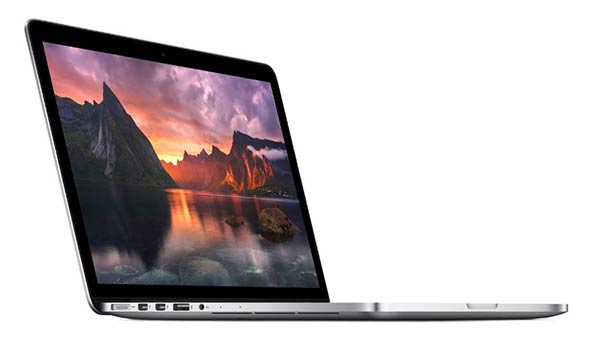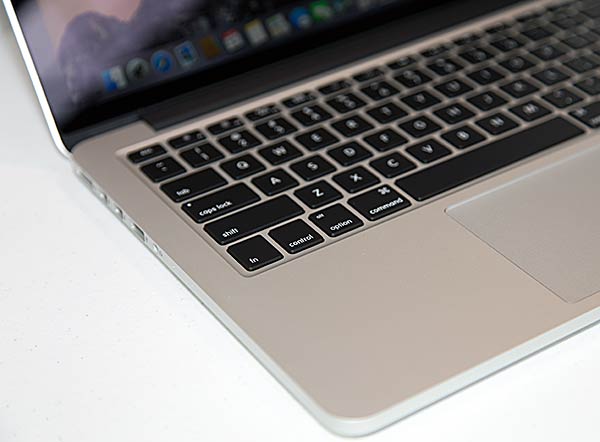|
October 2016: read and watch our review of the late 2016 13" MacBook Pro that replaces this model.
The 13" MacBook Pro with Retina display is new (again). And it looks pretty much the same as when Apple released the design in 2012. Is that a bad thing? Not really since it's still one heck of an attractive and well-made unibody aluminum laptop that somehow still looks fresh. The lines are clean, there are no visible seams, and it's curvy in the right places and straight on the sides to make it look sturdy and elegant. The display bezel isn't overly large, unlike the MacBook Air, and the keyboard is as ever excellent. So if it looks the same as last year's model, what's new? It has the latest Intel Broadwell 5th generation CPUs and Intel Iris 6100 graphics for a speed boost. The mini DisplayPorts can drive a 4K monitor at 60Hz rather than the old model's 30Hz. SSD storage speed has doubled and there's the new Force Touch trackpad. That's a decent improvement list, and the price remains the same throughout the range of configurations. The 2650 x 1600 IPS "Retina" display with 310 nits of brightness and 94% sRGB coverage is the same as previous models and there's dual band WiFi 802.11ac and Bluetooth for wireless. All configurations have at least 8 gigs of RAM and you can get it with a variety of SSD capacities. As ever, this isn't a laptop that's easy to open up and upgrade (only the SSD is somewhat easy to service), so keep that in mind if you're a tinkerer.
Ports, Force Touch Trackpad and keyboard
The port arrangement is the same as the 2014 model, with two USB 3.0 ports, two Thunderbolt 2/mini Display Ports, full size HDMI, 3.5mm audio and an SD card slot. It uses the same MagSafe magnetic charging connector and lacks the new MacBook's USB-C port (not that we see a need for it at this point). It has a healthy selection of ports for a 13.3", 3.48 lb. Ultrabook class machine and the only thing you might need to add is Ethernet via Apple's Thunderbolt Ethernet adapter or USB to Ethernet adapter (both sold separately and we recommend the Thunderbolt option since few folks need two Thunderbolt ports and the Thunderbolt adapter offers faster data transfer speeds).

Apple makes perhaps the best trackpad on a laptop, regardless of OS platform. Somehow they've managed to make it even better with the Force Touch trackpad. It might sound like a gimmick, but it's actually more accurate and efficient. On normal trackpads just the bottom edge moves. For large trackpads, it's easy to have the hand and fingers wander higher, where it will do no good because the top half doesn't register clicks (unless you enable tap to click). With the Force Touch trackpad, you can click in any corner and there are four spring-like mechanisms under each spot. Yes, the trackpad actually does move just a little, and your mind will tell you it moves quite a bit thanks to the force feedback that creates the sensation of a tactile click (what Apple calls their Taptic engine--a cross between tap and haptic). You can even adjust the force setting in trackpad settings for a light, medium or heavy touch and feedback. The end result is a trackpad that feels even more responsive and precise. I generally hate clicking trackpads because it slows me down and the required force causes my pointing finger to wander, resulting in errors. Problem solved with the Force Touch trackpad. I've stopped using tap to click in fact, which was my old preferred method even though it wasn't very precise and sometimes resulted in accidental clicks.
Even more interesting, there's a secondary deeper click if you continue to press down with some force. That can bring up a word definition in quite a few programs and in Safari force-clicking on a link brings up a small preview of the web page. I'm sure Apple and third party developers will come up with even more uses. Trivia: when the laptop is turned off, the trackpad doesn't move at all; it's locked in the up position.
The keyboard is unchanged, and that's fine with us: it's one of the better backlit keyboards on the market with good tactile feel, dampened keys that don't clatter and a completely normal layout (by Mac standards).

Performance and Horsepower
The 13" Retina Mac's claim to fame is the more powerful 28 watt CPUs and higher tier integrated graphics that are faster than Windows Ultrabooks running on the usual 15 watt U series ULV CPUs and the MacBook Air. For those who intend to use this as their main machine and do more than web, streaming video, email and occasional photo and video editing, the 28 watt CPU is an attractive proposition. It allows for very tolerable speeds when editing/exporting 1080p video, can handle large spreadsheet calculations and program compiles for long programs comprised of 10's of thousands of lines of code. It's also quicker with VMs (virtual machines) than a lower wattage laptop. The Intel Iris 6100 graphics are at the top of the laptop heap for integrated GPUs and it's stronger than the HD 5500 graphics used in Windows Ultrabooks and the HD 5300 used in the 12" MacBook. It boosts game frame rates by 5 to 8 fps compared to the mid 2014 13" MacBook Pro with Retina display, and that was already a stronger than average laptop with last generation Intel Iris 5100 graphics. It's not enough of a change to upgrade if you own that mid-2014 machine, but it has a competitive edge against current Windows Ultrabooks and will be a speed demon if you're upgrading from a 3 year old dual core Mac laptop. Sorry, there's still no dedicated graphics option, and that's a rare feature on 13" laptops.
Apple offers the 13" Retina with 5th generation (Broadwell) Intel Core i5 and i7 CPUs. The base model is the 2.7 GHz Intel Core i5-5257U, and there's a 2.9GHz Core i5 option and a 3.1 GHz Core i7. All are dual core, four thread CPUs with Turbo Boost, though the Turbo Boost numbers wildly higher than base speed given the already fast base clock speeds. CPU performance gains are modest with Broadwell since Intel focused on improving battery life and graphics rather than computational prowess. Again, it's probably not enough of a gain if you own the Haswell model unless you love having the newest and fastest stuff, but this machine walks circles around the 15 watt competition and can even keep up with a 2012 15" Retina MacBook Pro in computational tasks.

The laptop is available with 8 gigs of RAM standard, and you can order it with 16 gigs for $200 more. 16 gigs seems like overkill for a dual core 13" laptop, but the choice is there for those who need it. Given that the Core i5 and i7 CPUs use the same architecture and core count, I don't feel it's worth the money to get the Core i7. If you need that much computing power, consider a larger laptop with a quad core CPU like the 15" MacBook Pro with Retina display (wait until Apple releases the 2015 refresh if you can though). The $1,299 base model has a 128 gig SSD and the $1,499 model has a 256 gig SSD (higher capacity drives are available). As Apple promised, SSD speeds are indeed twice as fast as the last generation model, though the last gen SSDs are quick enough that I'm not sure anyone could perceive the improvement.
Heat and noise weren't a problem with the 2014 model (I know since I use one as my main work machine and push it hard). The same is true here: this is a largely silent machine that gets warm on the bottom thanks to conductive aluminum, but never hot (unless you're playing demanding 3D games like Skyrim). I've swapped it with my personal machine for testing, where it spent 10 hours a day driving both the internal LCD and a 27" Thunderbolt display in a mix of several web browsers, Photoshop CS6, Dreamweaver, Word, Excel, Mail, iMovie and social networking clients and I never heard the fan nor did it get hot to the touch (just toasty warm on the bottom). It never lagged and kept up with everything I threw at it, which is quite impressive for a 0.71", 3.5 lb. laptop.
|
|

